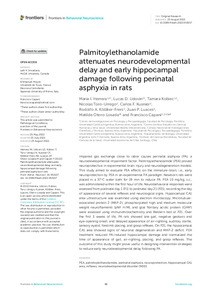Por favor, use este identificador para citar o enlazar este ítem:
https://repositorio.uca.edu.ar/handle/123456789/15243| Título: | Palmitoylethanolamide attenuates neurodevelopmental delay and early hippocampal damage following perinatal asphyxia in rats | Autor: | Herrera, María Inés Udovin, Lucas D. Kobiec, Tamara Toro Urrego, Nicolás Kusnier, Carlos Federico Kölliker Frers, Rodolfo Luaces, Juan P. Otero Losada, Matilde Capani, Francisco |
Palabras clave: | ASFIXIA PERINATAL; NEUROPROTECCION; PALMITOILETANOLAMIDA; DAÑO CEREBRAL | Fecha de publicación: | 2022 | Editorial: | Frontiers Media | Cita: | Herrera, M. I. Palmitoylethanolamide attenuates neurodevelopmental delay and early hippocampal damage following perinatal asphyxia in rats [en línea]. Frontiers in behavioral neuroscience. 2022, 16, 953157. doi: https://doi.org/10.3389/fnbeh.2022.953157. Disponible en: https://repositorio.uca.edu.ar/handle/123456789/15243 | Proyecto: | Neuroprotección en asfixia perinatal. Una aproximación traslacional | Resumen: | Impaired gas exchange close to labor causes perinatal asphyxia (PA), a neurodevelopmental impairment factor. Palmitoylethanolamide (PEA) proved neuroprotective in experimental brain injury and neurodegeneration models. This study aimed to evaluate PEA effects on the immature-brain, i.e., early neuroprotection by PEA in an experimental PA paradigm. Newborn rats were placed in a 37◦C water bath for 19 min to induce PA. PEA 10 mg/kg, s.c., was administered within the first hour of life. Neurobehavioral responses were assessed from postnatal day 1 (P1) to postnatal day 21 (P21), recording the day of appearance of several reflexes and neurological signs. Hippocampal CA1 area ultrastructure was examined using electron microscopy. Microtubuleassociated protein 2 (MAP-2), phosphorylated high and medium molecular weight neurofilaments (pNF H/M), and glial fibrillary acidic protein (GFAP) were assessed using immunohistochemistry and Western blot at P21. Over the first 3 weeks of life, PA rats showed late gait, negative geotaxis and eye-opening onset, and delayed appearance of air-righting, auditory startle, sensory eyelid, forelimb placing, and grasp reflexes. On P21, the hippocampal CA1 area showed signs of neuronal degeneration and MAP-2 deficit. PEA treatment reduced PA-induced hippocampal damage and normalized the time of appearance of gait, air-righting, placing, and grasp reflexes. The outcome of this study might prove useful in designing intervention strategies to reduce early neurodevelopmental delay following PA... | URI: | https://repositorio.uca.edu.ar/handle/123456789/15243 | ISSN: | 1662-5153 (online) | Disciplina: | PSICOLOGIA | DOI: | 10.3389/fnbeh.2022.953157 | Derechos: | Acceso abierto | Fuente: | Frontiers in behavioral neuroscience 16, 953157, 2022 |
| Aparece en las colecciones: | Artículos |
Ficheros en este ítem:
| Fichero | Descripción | Tamaño | Formato | |
|---|---|---|---|---|
| palmitoylethanolamide-attenuates.pdf | 3,8 MB | Adobe PDF |  Visualizar/Abrir |
Visualizaciones de página(s)
76
comprobado en 27-abr-2024
Descarga(s)
41
comprobado en 27-abr-2024
Google ScholarTM
Ver en Google Scholar
Altmetric
Altmetric
Este ítem está sujeto a una Licencia Creative Commons

